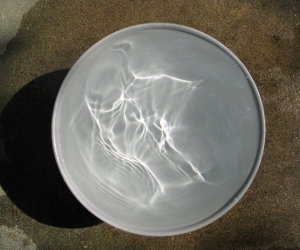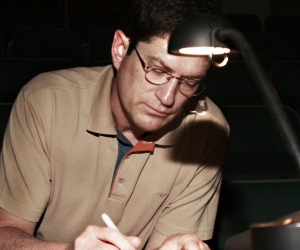
The Muted Note is a marriage of music, dance, and poetry—specifically, the poetry of the late Canadian writer P. K. Page. Her work was the unexpected catalyst for the first creative collaboration between Scott Thomson and Susanna Hood, both of whom were long-time linchpins of Toronto’s artistic scene before moving to Montreal in 2010. Trombonist Thomson, part of the bedrock of Toronto’s improvised music scene during his time in the city, was a member of numerous ensembles there—the AIMToronto Orchestra (which he remains codirector of), The Lollipop People, Woodshed Orchestra, and his own quintet The Rent; and was additionally a cofounder of AIMToronto (Association of Improvising Musicians Toronto), and founder of the music venue Somewhere There. Dance artist and vocalist Hood was the founder and artistic director of the interdisciplinary project Hum and a veteran of companies such as Toronto Dance Theatre. Despite their overlapping careers and long-time friendship, Hood and Thomson only started working together after their personal lives began to intertwine.
Their first collaboration was in the context of The Rent, a repertory ensemble formed with saxophonist Kyle Brenders to explore the music of American soprano-sax legend Steve Lacy. Instrumental interpretations of Lacy works featured settings of poetry by numerous poets from around the world, which in turn led Thomson to ask himself, What if . . . ?
“It dawned on me that Susanna would be a fascinating interpreter of that repertoire, and I got really inspired by that project. While I’d written music in other veins, I’d never really written a song in conventional form,” he explains. “When we moved to Montreal, I thought it would be great to write some songs specifically for Susanna’s voice. So the genesis of The Muted Note is creating material for us to play together, and it has unfolded as several streams of playing the same book of songs in different contexts, in different formations, in different scopes.”
It was the couple’s wedding in 2010 that led them to Page. They received a gift certificate for a Toronto bookshop, and Thomson picked up The Essential P. K. Page (The Porcupine’s Quill). He’d read Page’s work when he was an English-literature undergrad, but hadn’t connected with it back then. This time was different, he says: “Opening up the book, it was just so clear that there was so much music in there.
“And there’s a quality in her writing that’s really important in the context of this work—the poetry’s not primarily about her, it’s not about her self-expression, it’s not about her emotional state, it’s not even biographical, except in a residual way. She’s focused on the details and nuances of the world around her.”
“And,” Hoos adds, “coming from a point of view of a state of wonder, which is quite inspiring.”
“Yes, humility and wonder,” Thomson agrees. “And it was so touching to make this work that reflected such a love for the world around her and its tiny, massive details.”
Thomson asserts that the poetry remains the “absolute core” of the work it has inspired. “The music and songs serve the poetry. They don’t conceal or limit it in any way, they animate it in different ways. So in that sense, the dance extends and also relates directly to the poetry. The over-arching goal—whether it’s just the two of us playing as a duo, or with an entire stage production—is to create a work that’s not a music show, not a dance show. It’s poetry plus music plus dance, and the three media are serving each other and serving the foundation, which is the poetic texts.”
The suite of eleven songs composed for the voice-and-trombone duo, which can be heard on the 2013 recording The Muted Note (& Records), shows careful restraint and reverence for the source material, even as Hood sings dramatic Page lines such as “Go out of your mind / Prepare to go mad.”
Hood and Thomson were encouraged to record the songs in the duo format by their friend and collaborator, drummer–composer Michel F. Coté, who is also a cofounder of & Records. At the time of recording, they were well on their way to becoming deeply entrenched in Montreal’s active free-improvising scene, which was then centred around L’Envers, the loft performance space run by trumpeter Ellwood Epps. In 2013 Thomson assembled a new quintet, The Disguises—comprising alto saxophonist Yves Charuest, bassist Nicola Caloia, drummer Pierre Tanguay, Thomson, and Hood—to play his songs.
It wasn’t long before they began to imagine The Muted Note as a larger work. Movement soon became the next natural extension.
“I have a three-to-four-year creative cycle, and right when we moved to Montreal, I’d come to the end of one and sort of spent some time readjusting to the new surroundings and changes in my life, personally and artistically,” Hood recalls. “I was fascinated to see where approaching song from a choreographic point of view would take me.
“I’d already spent a good ten or twelve years finding intersections between sound, movement, and dance in very interesting hybrid ways, but when I started working with Scott’s group in Toronto, all of a sudden this whole inspiring and humbling new approach became available to me. Right from the start, my approach to the Lacy music was, obviously, singing the lyric, but then figuring out how to improvise on song structure—which was something I hadn’t done so much—and to do that both vocally and physically. Dance and physical expression are my first language—that’s always been my way into singing. So when this new suite came along, right away I was working with that material both physically, through the movement of flesh and bones, and also through vocal connection.”
As the duo expanded the sonic palette of The Muted Note with The Disguises, Hood also began to expand the range of movement by engaging other dancers, in part to ease the physical demands made on her by dancing while singing. For the large stage-work, which premiered in September 2014, the quintet is joined by dancers Alanna Kraaijeveld, Ellen Furey, and Bernard Martin.
Yet this evolution of sound and motion all leads back to The Muted Note’s foundation in the poetic work of Patricia Kathleen Page, one of the key Canadian modernist poets of the twentieth century. Page, who died in 2010 at the age of 93, was born in England and moved to Canada at the age of three, living in Red Deer, Calgary, Winnipeg, and Victoria. After marrying the then National Film Board of Canada commissioner W. Arthur Irwin, a former Maclean’s editor and soon-to-be diplomat, she lived in Australia, Brazil, Mexico, and Guatemala. As P. K. Page, she published over thirty books; as visual artist P. K. Irwin, she created works that are now in the permanent collections of the National Gallery of Canada and the Art Gallery of Ontario. Page’s first major prize was a 1954 Governor General’s Award for “The Metal and the Flower,” one of the poems that Thomson has adapted for The Muted Note. The title of the song suite comes from her poem“The Understatement”: “and so I use the under-emphasis, / the muted note, the less than purely rounded.”
“I thought it was a nice encapsulation of exactly what we’re describing,” explains Thomson. “The unmuted note would seem to be the expressive note, the one that sings itself. The muted note is one that looks outward and tries to express itself through things.”
Is The Muted Note, then, an expression of the openness of spirit that, for some, accompanies middle age? “Well, we got married,” smiles Thomson, “and that’s a transition in life. As a couple, that experience focused our attention on all that’s happened in the world, all that could unfold.”
Adds Hood: “In terms of looking upward and listening and responding to what’s outside one’s self, I think what’s needed is something in your make-up as a human being, regardless of your age, and maybe that’s what’s crystallized for us now.”
FYI: The Muted Note—which is arranged for duo, for quintet, and most recently as a full theatrical production with band and dancers—is presented in its various forms across Canada in Fall 2014. The theatrical version of the work premieres Sept. 5 2014 at The Citadel in Toronto.
Image: The Muted Note dancers Alanna Kraaijeveld (foreground) and Ellen Furey. Image by: Alejandro De Leon/Lost and Found Media Lab


